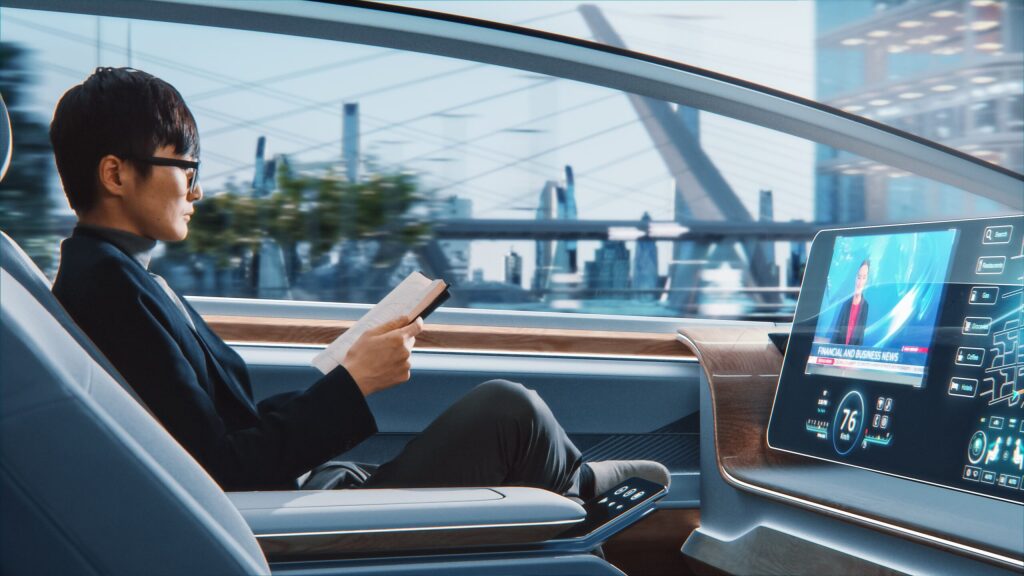Have you ever wondered how self-driving cars work? These vehicles, which are often call autonomous vehicles (AVs), use a mix of sensors, cameras, and AI to “see” and respond to everything around them – from other cars to people crossing the street.
Let’s talk about how these cars are changing our cities. It’s not just about having a cool new toy; self-driving cars are completely reshaping how our cities work and how we get around. Think of it as giving our cities a major upgrade.
One of the biggest perks? Fewer traffic headaches. These cars communicate with each other and traffic systems in real time, which means smoother traffic flow. They’re constantly crunching traffic patterns and weather data to make smart decisions. Soon, we might even have what experts call a “Moving Web” – imagine being able to plan your entire trip and book rides all in one place.
The numbers are impressive. The World Economic Forum (WEF) thinks that by 2035, self-driving vehicles could handle 85% of last-mile deliveries. Cities like San Francisco, Singapore, and Phoenix are already testing these vehicles on their streets. By 2030, experts predict that up to 15% of new cars sold could drive themselves.
Here’s something interesting about fuel efficiency – self-driving cars can cut fuel use by up to 20% just by driving more smoothly and at better speeds. For electric vehicles, this tech helps drivers figure out when and where to charge, making the whole experience much more practical.
However, it’s not all smooth sailing. We need to talk about the tough questions, like how these cars should handle difficult situations. We can’t ignore the ethical challenges these self-driving cars bring up.
Programmers face real dilemmas when teaching these vehicles how to handle accidents or dangerous situations. It’s not just theoretical anymore – they need to program exactly how the car should respond in split-second decisions where there might not be a clear “right” answer. These are the kinds of tough ethical choices we’ve got to figure out as this technology develops.


The National Association of City Transportation Officials (NACTO) has some clear ideas about this. They say self-driving cars should work with public transit, not against it, and keep everyone safe – whether they’re in a car, on a bike, or walking.
Data privacy and security emerge as critical issues as AVs generate and process vast amounts of information. Ensuring the protection of personal data and guarding against potential cyber threats become paramount. Moreover, the potential for algorithmic bias in AV decision-making systems must be addressed to prevent unintended discrimination or unfair treatment of certain groups.
The changes go beyond just transportation. Cities might look different too. We might need fewer parking spots, which means more room for parks, walking areas, or community spaces. And instead of traditional traffic lights, we might see something called slot-based intersections, similar to how air traffic control works.
The impact of AVs on the workforce cannot be overlooked. While they may create new job opportunities in technology and maintenance, they also pose challenges for traditional driving professions. Policymakers and industry leaders must work together to manage this transition, ensuring workers are reskilled and new opportunities are created.



Companies are racing to develop this technology. Big names like Toyota, Ford, and LG Electronics are leading the pack with thousands of patents. They’re all working to push the technology forward.
Public transportation isn’t going away – self-driving cars should make it better, not replace it. Think of them as filling in the gaps, like getting you from the train station to your final destination. The integration of AVs with public transport can create a more flexible, efficient, and accessible urban mobility ecosystem.
5G technology is crucial here. It lets these cars communicate super fast with everything around them. Edge computing helps too, making sure the cars can make split-second decisions safely.
Looking ahead to 2025, experts think we’ll see some big steps forward in self-driving technology. Of course, a lot depends on what happens with regulations and government decisions.
Self-driving cars are reshaping our urban landscape in ways we are just beginning to understand. While we’re still working through challenges around safety and fairness, the potential is clear. With careful planning and the right approach, these vehicles could help create cities that work better for all of us – more efficient, more sustainable, and more enjoyable to live in.









